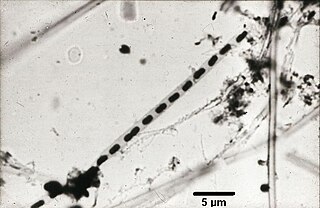
The Comamonadaceae are a family of the Betaproteobacteria. Like all Pseudomonadota, they are Gram-negative. They are aerobic and most of the species are motile via flagella. The cells are curved rod-shaped.
Oceanospirillaceae is a family of Pseudomonadota. Most genera in this family live in environments with high concentrations of salt; they are halotolerant or halophilic. They are marine, except Balneatrix which is found in fresh water and Venatorbacter, which is from terrestrial origin.All members are strictly aerobic, except Neptunomonas which can perform fermentation reactions.
The Alteromonadaceae are a family of Pseudomonadota. They are now one of several families in the order Alteromonadales, including Alteromonas and its closest relatives. Species of this family are mostly rod-like shaped and motile by using one polar flagellum.
The Ectothiorhodospiraceae are a family of purple sulfur bacteria, distinguished by producing sulfur globules outside of their cells. The cells are rod-shaped, vibrioid, or spirilla, and they are able to move using flagella. In general, they are marine and prefer anaerobic conditions. Ectothiorhodospiraceae are a vibrio bacteria that require salty living conditions to survive and grow: classifying them as slightly halophilic. Like all purple sulfur bacteria, they are capable of photosynthesis. To complete this energy process, Sulfur compounds are used as electron donors for carbon fixation in the pentose phosphate pathway. This elemental sulfur accumulates outside of the cells.
The Oceanimonas are a genus of marine bacteria. They are, like all Proteobacteria, gram-negative. The rod-shaped, motile organisms are aerobic and chemoorganotroph.
Kofleriaceae is an aerobic family of bacteria from the order of Myxococcales.
Rhodanobacter is a Gram-negative and non-motile genus of Pseudomonadota.
The Hahellaceae are a family of Pseudomonadota in the order of Oceanospirillales.
Hahella is a Gram-negative, facultatively anaerobic genus of bacteria from the family of Hahellaceae.
Phocoenobacter is a Gram-negative and rod-shaped genus of bacteria from the family of Pasteurellaceae with one known species. Phocoenobacter uteri has been isolated from the uterus of a harbour porpoise from Inverness in Scotland.
Halorhodospira is a Gram-negative genus of bacteria from the family of Ectothiorhodospiraceae. Halorhodospira bacteria occur in hypersaline and extreme saline habitats.
Halochromatium is a Gram-positive and motile genus of bacteria from the family of Chromatiaceae. Halochromatium bacteria occur in microbial mats from hypersaline habitates.
Isochromatium is a Gram-negative, obligately phototrophic and strictly anaerobic genus of bacteria from the family of Chromatiaceae with one known species.
Lamprobacter is a Gram-negative, rod-shaped and motile genus of bacteria from the family of Chromatiaceae with one known species. The habitat of Lamprobacter bacteria is hydrogen sulfide-containing mud and saline water.
Thiococcus is a Gram-negative, non‐motile, obligately phototrophic and strictly anaerobic genus of bacteria from the family of Chromatiaceae with one known species. Thiococcus pfennigii was first isolated from salt marshes.
Thiohalocapsa is a Gram-negative and non-motile genus of bacteria from the family of Chromatiaceae.
Thiorhodococcus is a Gram-negative genus of bacteria from the family of Chromatiaceae.
Thiorhodovibrio is a Gram-negative genus of bacteria from the family of Chromatiaceae.
Oceanimonas baumannii is a Gram-negative and motile bacterium from the genus of Oceanimonas which has been isolated from estuarine mud from the River Wear in England.
Alterococcus agarolyticus is a Gram-negative, facultatively anaerobic, halophilic and thermophilic bacterium from the genus of Alterococcus.

